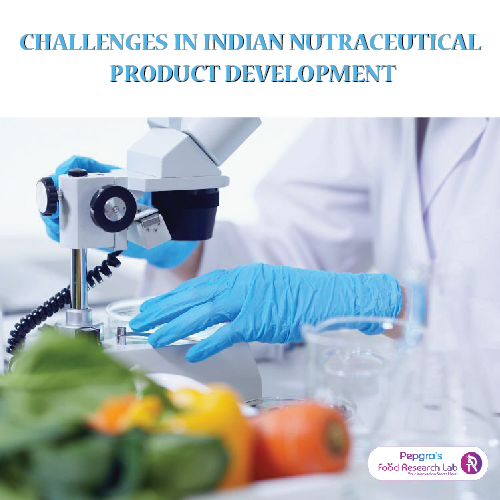
Indian Nutraceutical Product Development’s Obstacles
Introduction
Nutraceutical product development has numerous benefits but still faces many challenges in India, and the food research lab intends to address these issues. Nutraceutical formulations are thought to provide physiological benefits or immunity against subsequent diseases such as stress, cardiovascular disorders, diabetes, cancer, Parkinson’s and Alzheimer’s, neurological, pulmonary and respiratory illnesses, and may act as immunomodulators.
Although it may be simple for a nutraceutical product development contract R&D to create pharmaceutical tablets, powders, capsules, suppositories and so on incorporating bioactive food, obtaining sufficient bioavailability for such nutraceuticals is extremely difficult.
Nutraceutical product development and functional meals with different characteristics have the potential to provide unique goods to the globe at large. Nutraceutical formulations experience many problems that limit their efficacy. Better-characterized and research-proven goods made by nutraceutical contract manufacturing will assist in boosting customer confidence in nutraceutical and functional food items worldwide.
Nutraceutical Product Development Challenges
Nutraceuticals appear to be distinguishable from functional foods in a variety of ways that challenge the regulatory ideas of food and pharmaceuticals. There are two obvious concerns to the nutraceutical formulation industry: regulatory uncertainty and the trustworthiness of labelling claims. Regulatory ambiguity arises both nationally, providing the regulatory quagmire in which the nutraceutical contract manufacturing are now surviving, and in export markets due to a lack of international agreement on how to label nutraceuticals.
Several plants have varying degrees of the same medicinal activity. For example, more than 100 plants have been found to have anti-diabetic or hypoglycemia effects in India. Nutraceutical contract manufacturing companies delays in identifying such compounds due to lack of communication and indigenous knowledge.
The limited solubility, stability, and permeability of the bioactive component in the gastrointestinal tract frequently jeopardise bioavailability. Curcumin, for example, has low oral bioavailability due to shallow blood levels, restricted tissue distribution, apparent quick metabolism, and a short circulation half-life. Another example is probiotics encapsulation technology (PET), which has recently been developed as a mechanism for probiotic delivery. Biomaterial selection, solvent type, and toxicity are all factors that contribute to cell survival. The selection of appropriate technology is critical in the formulation of probiotics.
Drug delivery refers to the process of efficiently and safely introducing an active medicinal component into the body. The introduction of innovative delivery systems into the nutraceutical sector has been delayed due to their complexity, high cost, and time consumption. As a result, conventional forms have been utilised for many years, yet, as previously stated, they have several flaws. Nutraceutical contract manufacturing and nutraceutical product development dwell under this issue. Traditional herbal dosage formulae have been created for many years. Permeation enhancers, surface modifiers, prodrugs, colloidal lipid carriers, and other new carriers, for example, have been created.
The inherent powderiness of free phytosterols due to their crystalline form is another problem for food ingredient manufacturers. The particle size of solid components has a significant impact on the organoleptic characteristics of meals, such as taste and feel. Insoluble particles may contribute to grittiness and coarseness, which contribute to the overall mouthfeel of meals.
One difficulty that has been overlooked is raising public awareness about the need to make healthy eating choices. Individual choice is the single most important driving element in the food souk’s expansion. It is now possible to assume that individual customers eat what they choose.

Solutions for nutraceutical formulation
The worldwide approach to nutraceutical regulation and marketing is very diversified. This is mostly due to the difficulties in classifying such items, the lack of an adequate regulatory class for these hybrid products, and varying perspectives on what is regarded to be sufficient scientific proof to conclude their functionality. The unified approach to breaking this barrier can help create a universally acceptable definition. India recently put its definition on the FSSAI site, and the FDA and EU have bought in their regulatory changes.
When the ethnobotanical method is used for drug development, information available from traditional knowledge holders is shared. Respecting the intellectual property rights of a certain cultural group, tribe, or local people in a place where plants are harvested based on their ethnomedical expertise is vital.This can help lead to understanding more and extracting the right and new sources.
The introduction of nanotechnology for pharmaceutical uses has created a new route for improving the stability, solubility, or permeability of problematic nutraceuticals. The purpose is to promote health and wellness as people’s average ages increase.The addition of generics into the market may reduce the price of a few nutraceuticals, but people’s reliance on such goods and their expanding reach indicate that market growth will remain constant.
Conclusion:
The global use of nutraceuticals is quickly increasing, owing to their stated safety and efficacy. The use of sophisticated nanosized drug delivery systems as a platform for nutraceutical composition has recently gained popularity. This is inspired by the encouraging findings for the nutraceuticals evaluated in bioavailability, safety, targeting, and stability. As a result, numerous drug delivery methods, such as nanoparticles, liposomes, dendrimers, phytosomes, nanoemulsions, and others, were developed.
However, there are several obstacles associated with nutraceutical formulation regarding efficacy, safety, and regulatory compliance. Concerned institutions have not identified a worldwide definition. Globally, regulatory agencies have not been established to control and regulate nutraceuticals.





